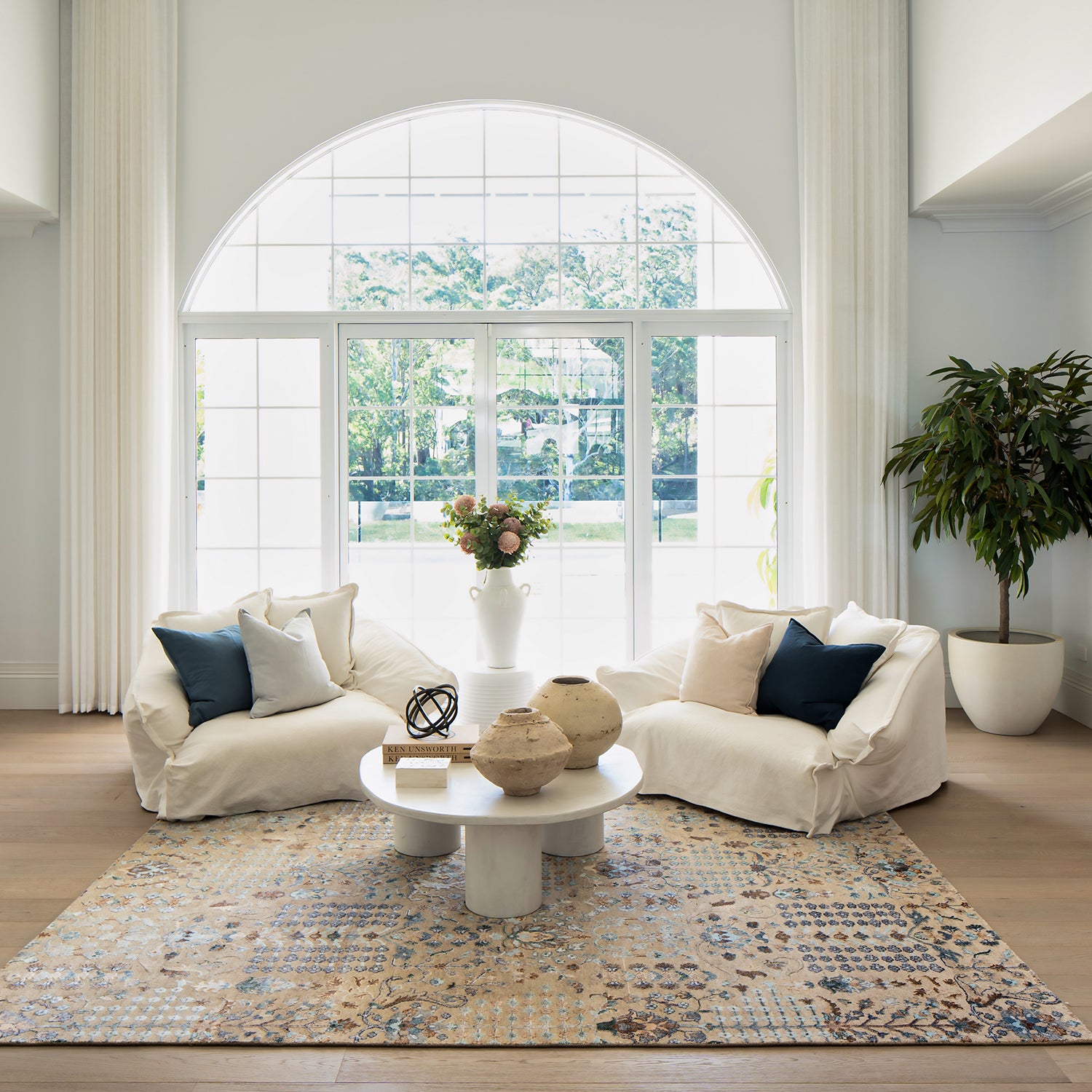A rug possesses unparalleled power to unite a room. Many believe that the hue or design reign supreme when selecting a rug. However, the dimensions of the rug hold equal significance in achieving flawless placement within the space.
Size of the Rug
The larger the room, the larger the rug that you will need. If you want the rug to fill the space, you should leave about 50 centimetres between the rug and the wall, to create a pathway. This will also stop your rug from looking too big. Remember you should always measure your room and the size of furniture that you wish your rug to fit under before buying a rug.
The Shape of the Rug
Rectangular shapes are favoured for styling medium or large-sized rooms, but round and irregularly shaped rugs add charm and a unique style to small spaces and nooks. They also complement round dining tables and office spaces.
Rug Style
The style of your new rug will depend on your décor. For instance, an oriental-style rug is not ideal in a highly modern room. While a bright, modern rug is out of place in a traditional look interior design. You will need to decide on your design theme, this way you can choose the perfect rug that will suit your space.
Foot Traffic and Your Rug
While we often forget about this when choosing a rug, foot traffic is also very important. If the rug is for a hallway or children’s room, you will need a rug that is hard-wearing and durable.
Wool rugs are soft and comfortable underfoot, which makes them perfect for living spaces where people are less likely to walk around often and are unlikely to be wearing shoes. Always in the end consider how the space is going to be used before choosing a rug and fibre type.
Rug Placement for Living Rooms
The living room is the focal point of the residence and the primary gathering space for families. Accordingly, it is frequently adorned with exquisite furnishings and exquisite home décor, creating an environment of utmost elegance.
Rug placement should anchor your seating arrangement in a room. It doesn’t necessarily have to fill the whole room, but it should at least reach the front two legs of your couch and the main chairs on the rug. You should also leave at least a 30cm border between the rug and the walls.
That said, a rug needs to be big enough to put all the feet of the furniture within the room on the rug. Ideally, the furniture should sit on the rug with 5-10cm of the rug visible behind or beside the feet.
Rug Placement in A Bedroom
There’s nothing better in the mornings than getting out of bed and stepping onto a soft, comfortable rug. But with the bed taking up most of the space in the room, as well as the chest of drawers, and wardrobes, you must think carefully about how you will place a rug.
Depending on the size of the room, aim to place the rug under at least two-thirds of the bed. You might also consider positioning all of the bed and bedside tables on the rug.
There are, however, a couple options for rug placement. Assuming the head of the bed is against a wall:
- A rug of about 240cm x 330cm is placed under the bed, so the edges come out from both sides of the bed, as wide as your bedside tables. The top of the rug, however, should not reach the bedside tables, or the wall.
- A small rug, around 160cmx 230cm reaches from just before the base of the bed, to halfway under the bed, providing a little rug on each side.
- A rug about 240cm x 300cm that covers under the bed and the bedside tables, up to the back legs.
- A very large rug, around 300cm x 400cm gives a large amount of rug space at the bottom and sides of the bed and ends just before the back legs of the bed and bedside tables.
Dining Room Rug Placement
Dining room rugs contribute an air of sophistication and elegance to any space. They must possess ample size to accommodate the chairs, ensuring a level surface for your feet. Nothing is more uncomfortable than sitting on an unsteady chair.
You should choose a rug that extends out at least 60cm on each side of the table so there’s room for you to pull out chairs. As a result, most tables need a rug that is at least 240cm wide. If you have an extendable table, you need to ensure your rug still works if you open the table out fully. But remember, if you rarely open the table fully then most people will opt to choose a rug that will look good in the dining room as it is used most of the time.
A good rule of thumb to remember is:
- 140cm to 203cm dining table needs a 240cm x 330cm rug.
- A round table around 112cm in diameter needs a 200cm x 290cm rug or a 240cm x 240cm rug.


